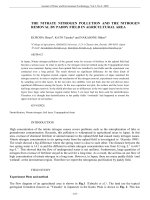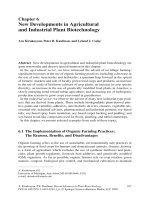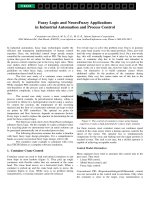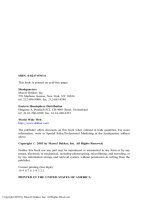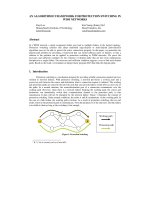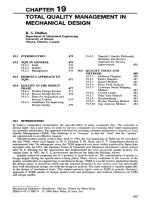Bee Pollination in Agricultural Ecosystems doc
Bạn đang xem bản rút gọn của tài liệu. Xem và tải ngay bản đầy đủ của tài liệu tại đây (3.68 MB, 247 trang )
Bee Pollination in Agricultural Ecosystems
This page intentionally left blank
Bee Pollination in Agricultural
Ecosystems
Edited by
Rosalind R. James and Theresa L. Pitts-Singer
1
2008
1
Oxford University Press, Inc., publishes works that
further Oxford University’s objective of excellence
in research, scholarship, and education.
Oxford New York
Auckland Cape Town Dar es Salaam Hong Kong Karachi
Kuala Lumpur Madrid Melbourne Mexico City Nairobi
New Delhi Shanghai Taipei Toronto
With of ces in
Argentina Austria Brazil Chile Czech Republic France Greece
Guatemala Hungary Italy Japan Poland Portugal Singapore
South Korea Switzerland Thailand Turkey Ukraine Vietnam
Copyright © 2008 by Oxford University Press, Inc.
Chapters 1, 4, 6, 7, 8, and 13 were prepared by the authors as part of their
of cial duties as U. S. government employees, and are in the public domain.
Published by Oxford University Press, Inc.
198 Madison Avenue, New York, New York 10016
www.oup.com
Oxford is a registered trademark of Oxford University Press
All rights reserved. No part of this publication may be reproduced,
stored in a retrieval system, or transmitted, in any form or by any means,
electronic, mechanical, photocopying, recording, or otherwise,
without the prior permission of Oxford University Press.
Library of Congress Cataloging-in-Publication Data
Bee pollination in agricultural ecosystems / edited by Rosalind R. James and
Theresa L. Pitts-Singer.
p. cm.
Includes bibliographical references and index.
ISBN 978-0-19-531695-7
1. Bees—Control—Environmental aspects—United States. 2. Pollination
by insects. 3. Agricultural ecology—United States. I. James, Rosalind R.
II. Pitts-Singer, Theresa L.
QK926.B34 2008
577.5'5—dc22 2007043146
9 8 7 6 5 4 3 2 1
Printed in the United States of America
on acid-free paper
FOREWORD
It was not until the eighteenth century that the subject of this book, the pollination
services of bees, began to be understood and valued. Nevertheless, the association
between man and bees has been long and close, and dates from at least 2400
BC.
Beekeeping with the Western honey bee, Apis mellifera, was a well-developed craft in
ancient Egypt during the fth dynasty of the Old Kingdom. When Christopher Columbus
and his companions landed in Cuba in 1492, the local inhabitants greeted them with
gifts of honey from a local native stingless honey bee, Melipona beecheii, which was, and
still is, managed in log hives by native peoples in the neotropics.
Man’s close association with bees led to a remarkable cultural convergence between
two of the great dynastic cultures: in ancient Egypt, the hieroglyph of a honey bee was a
symbol of royalty, and for the Mayans of Central America a pictograph of a stingless bee
was a symbol of kingship.
It is easy to see why this should be. On both sides of the Atlantic Ocean, honey and
hive products such as wax and propolis from social bees were and are important com-
modities in human commerce, both as food and a source of cosmetic and medicinal
substances. Together with fermented honey drinks, these honey bee and stingless
bee products had immediate and obvious value and made it inevitable that apiculture
would evolve into a respected craft that would often be accorded religious and magical
status.
We can surmise, however, that an unwitting relationship with bees dates back even
further. When our immediate ancestors embarked on the evolutionary path to bipedal-
ism and a hunter-gatherer lifestyle, they could do so because of a savannah biotope with
structural and oral features resulting from the coevolved interactions between those
keystone mutualists extraordinaire, bees and owering plants.
vi Foreword
Now we are mostly not hunter-gatherers and we have produced new habitats, the
agroecosystems, where intensive agriculture has resulted in crop yields undreamed of a
couple of generations ago. In so doing, we have not emancipated ourselves from depen-
dency on bees: we rely on them to pollinate 63 of the 82 (77%) most valuable crops.
Worldwide, bees pollinate more than 400 crop species and in the United States more
than 130 crop species.
This is not without some irony. While we still depend mightily on the pollination
services of bees, we have devastated natural oras and insect faunas in creating vast,
structurally uniform monocultures that are far from bee-friendly. Hence, the next stage
in the evolution of man’s close relationship with bees: the migratory beekeeper. In the
ecological disaster zone known as California’s Central Valley, vast numbers of honey
bee colonies from as far away as Texas and Florida are trucked in each year for the pol-
lination of almonds. In 1994 this involved the rental of 1.4 million honey bee colonies.
By 2012, it is estimated that 2 million colonies will be needed for the ever-expanding
acreage devoted to almonds alone. At the time of this writing, there are about 2.9 mil-
lion honey bee colonies in North America, of which 2–2.5 million are rented out for
pollinating 13 crops.
The arithmetic of future needs, therefore, doesn’t quite add up. This, together with
the fact that honey bees are under growing pressure from parasites, disease, and colony
collapse disorder, has understandably led to the search for additional native bee species
as alternatives to honey bees as managed pollinators.
It is to the wildlands and their oras that we must look for new pollinator species,
and this is happening. However, we must conserve these reservoirs, many of which are
under pressure from urban sprawl and agriculture. To do this, we need to develop a
greater understanding at the community level of the dynamic network of relationships
between bees and owering plants. This is not simply for the economic bene ts of poten-
tial pollinators: we also accord aesthetic and recreational value to our wildlands.
Research on the nesting biology and management of native, solitary bees for spe-
ci c crops is now a growing eld. Moreover, we can enhance our use of the pollina-
tion services of these bees by attempting to overcome corporate agriculture’s horror
at the prospect of stands of native ora as supplementary forage in the vicinity of their
crops.
Biosecurity can be regarded as a recurrent theme in this book, whether it is con-
cern about pollen transfer from genetically modi ed crops to related weed species, medi-
ated by the foraging movements of bees, or the unforeseen and detrimental interactions
between invasive plants and native bee faunas. Unforeseen and adverse ecological effects
also occur when bee species and/or subspecies are moved outside of their natural ranges.
The best known example of this is the problem of “Africanized” honey bees, when bees
from sub-Saharan Africa were introduced into Brazil, crossed with European honey
bees (also nonnative), resulting in a multiplicity of well-known problems. Problems also
have occurred with the commercial management of bumble bees for greenhouse crops,
where subspecies of Bombus terrestris have been introduced outside of their natural
range, and now cases in England and Israel document the escape and establishment of
populations into the wild, with adverse effects on local bee faunas.
Foreword vii
The above issues are outlined and discussed in this book. These are pressing matters,
and this volume is therefore timely, not least because its contributors are leading current
thinkers and researchers in the eld. Collectively, the subjects they address indicate the
broad front of future research that is necessary if we are to consolidate our relationship
with bees and their sustainable exploitation and management.
The agenda is therefore set, and we will succeed. We have to. Otherwise, under “any
other business,” ecologically-minded people of my generation might well ask, “How will
my grandchildren cope with the food riots?”
Christopher O’Toole
Sileby, Leicestershire
England
Honorary Research Associate,
Hope Entomological Collections
Oxford University Museum of Natural History;
Science Director Almond Pollination Company
This page intentionally left blank
ix
ACKNOWLEDGMENTS
We extend our gratitude to the publisher, fellow scientists, and industry customers
for their encouragement in the production of this book. We deeply appreciate the dili-
gence, cooperation, and patience of all of the authors who did a fabulous and timely
job of writing and revising their chapters. Moreover, we thank the chapter reviewers
for their sincere and helpful comments, criticisms, suggestions, and edits. Our efforts
were expedited by assistance from Agriculture Research Service technicians Ellen
Klinger and Ellen Klomps and administrative assistant Amber Whittaker in ensuring
the uniformity and organization of the book. We also appreciate the diligence of our
research assistants, who made it possible for our research projects to continue, even as
we executed the production of this book. Finally, we thank our spouses for their loving
support.
This page intentionally left blank
xi
CONTENTS
Forword v
Christopher O’Toole
Contributors xiii
Part 1: Bee-Provided Delivery Services
Chapter 1 Bees in Nature and on the Farm 3
Theresa L. Pitts-Singer and Rosalind R. James
Chapter 2 Crop Pollination Services From Wild Bees 10
Claire Kremen
Chapter 3 Crop Pollination in Greenhouses 27
José M. Guerra-Sanz
Chapter 4 Pollinating Bees Crucial to Farming Wild ower Seed for U.S.
Habitat Restoration 48
James H. Cane
Chapter 5 Honey Bees, Bumble Bees, and Biocontrol: New Alliances
Between Old Friends 65
Peter G. Kevan, Jean-Pierre Kapongo, Mohammad Al-mazra’awi,
and Les Shipp
xii Contents
Part 2: Managing Solitary Bees
Chapter 6 Life Cycle Ecophysiology of Osmia Mason Bees Used as Crop
Pollinators 83
Jordi Bosch, Fabio Sgolastra, and William P. Kemp
Chapter 7 Past and Present Management of Alfalfa Bees 105
Theresa L. Pitts-Singer
Chapter 8 The Problem of Disease When Domesticating Bees 124
Rosalind R. James
Part 3: Environmental Risks Associated With Bees
Chapter 9 Environmental Impact of Exotic Bees Introduced for Crop
Pollination 145
Carlos H. Vergara
Chapter 10 Invasive Exotic Plant-Bee Interactions 166
Karen Goodell
Chapter 11 Estimating the Potential for Bee-Mediated Gene Flow in
Genetically Modi ed Crops 184
James E. Cresswell
Chapter 12 Genetically Modi ed Crops: Effects on Bees and Pollination 203
Lora A. Morandin
Chapter 13 The Future of Agricultural Pollination 219
Rosalind R. James and Theresa L. Pitts-Singer
Index 223
xiii
CONTRIBUTORS
Mohammad Al-mazra’awi, Department of Environmental Biology, University of
Guelph, Ontario, Canada
Jordi Bosch, Ecologia–Centre de Recerca Ecològica i Aplicacions Forestals (CREAF),
Universitat Autònoma de Barcelona, Bellaterra, Spain
James H. Cane, U.S. Department of Agriculture–Agricultural Research Service (USDA-
ARS) Pollinating Insects Biology, Management, and Systematics Research Unit,
Logan, Utah
James E. Cresswell, School of Biosciences, University of Exeter, UK
Karen Goodell, Evolution, Ecology, and Organismal Biology, Ohio State University,
Newark, Ohio
José M. Guerra-Sanz, Centro de Investigación y Formación Agrícola (CIFA) La
Mojonera, Instituto Andaluz de Investigación y Formación Agraria, Pesquera,
Alimentaria y de la Producción Ecológica (IFAPA), La Mojonera, Almeria, Spain
Rosalind R. James, U.S. Department of Agriculture–Agricultural Research Service
(USDA-ARS) Pollinating Insects Biology, Management, and Systematics Research
Unit, Logan, Utah
Jean-Pierre Kapongo, Greenhouse and Processing Crops Research Centre, Agriculture
and Agri-Food Canada, Harrow, Ontario, Canada
William P. Kemp, U.S. Department of Agriculture–Agricultural Research Service
(USDA-ARS) Red River Valley Agricultural Research Center, Fargo, North
Dakota
xiv Contributors
Peter G. Kevan, Department of Environmental Biology, Universityof Guelph, Ontario,
Canada
Claire Kremen, Department of Environmental Science Policy and Management,
University of California, Berkeley
Lora A. Morandin, Department of Environmental Policy and Management, University
of California, Berkeley
Theresa L. Pitts-Singer, U.S. Department of Agriculture–Agricultural Research
Service (USDA-ARS) Pollinating Insects Biology, Management, and Systematics
Research Unit, Logan, Utah
Fabio Sgolastra, Dipartimento di Scienze e Tecnologie Agroambientali, Area
Entomologia, Università di Bologna, Italy
Les Shipp, Greenhouse and Processing Crops Research Centre, Agriculture and Agri-
Food Canada, Harrow, Ontario, Canada
Carlos H. Vergara, Departamento de Ciencias Químico-Biológicas, Universidad de las
Américas-Puebla, Cholula, Puebla, Mexico
Part 1
Bee-Provided Delivery Services
This page intentionally left blank
3
1 Bees in Nature and on the Farm
Theresa L. Pitts-Singer and Rosalind R. James
Introduction
When we say that we work at “the Bee Lab,” most people automatically imagine us decked
out in bee suits, standing next to box-shaped hives, and holding our breaths amidst
a barrage of honey bees. Although our research facility is one of ve U.S. Department
of Agriculture’s Agricultural Research Service laboratories that are dedicated to bee
research, our focus is unique in its emphasis on non-honey bees that are important or
potential pollinators. The other four U.S. bee research facilities focus on honey bees,
examining various aspects of honey bee biology, pest control, management, and pol-
lination. As we have grown in our understanding of the importance of a variety of bees
as pollinators in agricultural systems, we have been inspired to compile this book.
This book illustrates the importance of both managed and wild bees in agricultural
ecosystems. For much of agriculture, the vital role that pollinators play in successful
crop or seed production is clear and direct. Commercially managed bees are available
for pollination services and are used in large commercial elds, small gardens, or enclo-
sures such as greenhouses and screen houses. Although the general public gives honey
bees much of the pollination credit, managed bumble bees and solitary bees also have
made a great impact on certain commodities, and wild bees provide free pollination ser-
vices that often go unnoticed. However, all of these bees are valuable and signi cant in
their liberal passing of pollen from one plant to the next. With the recent concern over
the unexplained loss of honey bee colonies, referred to as colony collapse disorder, it
seems ever more important to highlight some of the other bees that could be managed
for crop pollination.
4 Bee-Provided Delivery Services
Just how important are wild and managed bees in the agricultural ecosystem for the
successful production of seeds, fruits, and vegetables? What is the contribution of bees to
maximizing crop production and what is the effect of human manipulation and control
on both the bees and the plants they visit? Do we know how to use managed bees in
the most effective, sustainable, and pro table manner? Are novel uses of managed bees
awaiting discovery or implementation? What is the interplay of wild and managed bee
populations in natural and commercial settings? Revealing answers to such questions
and posing new questions in light of these answers are goals of this book.
Crop pollination by bees and other insects in temperate and tropical agricultural sys-
tems has been reviewed extensively in several informative books. These books often are
organized according to crop type or plant family or according to pollinator species and
their use for seed or fruit production. However, these books do not present a comprehen-
sive look at the ecology of bees in agricultural systems. Certain environmental factors
have a substantial impact on bee pollination ability and survival rates; conversely, the
bees can affect the ecosystem through their foraging activity, their interactions with
plants and other pollinators, and their invasiveness in novel localities. We invited bee
researchers and pollination biologists with various areas of expertise to highlight eco-
system-level approaches to and conceptions of the study of bees in agriculture. Some
authors highlight the overall ef ciency and effect of managed and wild bee activity in
elds and greenhouses or the novel use of bees for nonpollination functions such as the
spread of microbial pest control agents. Other authors address the details and dif culties
of managing solitary bees for alfalfa seed and tree fruit production, as well as the devel-
opment of new pollinators for nonfood seed crops. Considering environmental risks, the
nal chapters are dedicated to an ecological awareness of bees beyond crop production,
such as the impact of exotic bee introductions on other pollinators and plants, the inter-
actions of bees with invasive plant species, and how bees mediate gene ow within and
outside of elds of hybrid or genetically engineered crops.
We intentionally have omitted some topics related to bees in agricultural systems.
We decided not to include a chapter dedicated to honey bees because honey bee man-
agement is covered thoroughly in many other publications. Instead, we cover honey
bees as they relate to the various topics of discussion throughout the book. We also
do not include much discussion of the stingless bees in the tropics, mainly because
these bees are primarily utilized for a very small, specialized honey market and it is
still unclear whether attempts will be made to use them on a broader agricultural
scale. Exactly how these bees will be used and the extent of their use has not yet been
demonstrated.
Defi nition of a Bee
What exactly is a bee, and why are bees so important for pollination? Bee pollination is
best understood if one can rst distinguish bees from each other and from other related
insects and if we know their evolutionary and natural history. Bees, wasps, and ants
Bees in Nature and on the Farm 5
are in the insect order Hymenoptera. Genetically, the sex of all hymenopteran insects
is determined through the mechanism of haplodiploidy. For the bees, this means that
males have only one set of chromosomes (i.e., are haploid) and females have a pair of
chromosomes (i.e., are diploid). This can occur because male bees are produced from
unfertilized eggs and females develop from fertilized eggs. An egg-laying female can
control which eggs get fertilized and which do not, and in this way, she is able to con-
trol the sex ratio of her offspring. The sex ratio of the pollinator population is impor-
tant because female bees pollinate many more plants than males do. The main purpose
of females visiting plants is to collect enough pollen and nectar to feed their young.
Males, on the other hand, need to visit only enough plants to feed themselves (they
visit no owers if they are fed by the females, as occurs with honey bee and bumble bee
drones).
Bees and sphecid wasps belong to the superfamily Apoidea. The bees (called Apiformes)
can be distinguished from the wasps by the presence of erect, plumose hair on their
faces (Michener, 2000). Bees are very diverse and abundant, with more than 16,000
species worldwide (Michener, 2000). Yet the true number of bee species is basically
unknown, because not all have been given a name, and some have yet to be recognized
or discovered. Different sources give different answers about the exact diversity of bees,
and the variation in answers depends on what species were known at the time of the
publication and how the bees were classi ed. For example, for the region of North and
Central America, one nds reports of between 77 and 165 bee genera, represented by
between 2,600 and 4,900 species (e.g., Krombein et al., 1979; Michener et al., 1994;
Michener, 2000).
Unlike the predaceous wasps, bees are pollen collectors (with the exception of the
highly derived stingless bees, Trigona spp., that eat carrion). Bees probably came into
existence around 120 million years ago during the mid-Cretaceous, prior to the radia-
tion of angiosperms (Grimaldi & Engel, 2005). Because most modern bees are dependent
on the products of angiosperm owers—including pollen, nectar, and oils—the evolu-
tionary overlap of bees and angiosperms is not surprising. The coevolution of bees and
owers has resulted in special morphological adaptations for both insects and plants,
and the need of some plants for pollination by bees is absolute.
Over evolutionary time, some bees developed preferential relationships with only
one or a few plants (oligolecty), but others maintained a more general preference for
a wide range of owering plants (polylecty). And conversely, for some plants, only one
or a few bees are able to provide pollination with the proper behavior or morphology,
and these bees are often attracted to the plant by its unique fragrance or appearance
(Barth, 1991; Proctor et al., 1996). In at least one case, a plant, the death camus, pro-
duces a toxin to protect itself from herbivores, and few bee species are uniquely adapted
to ingest and thrive on the plant’s toxic pollen (e.g., Tepedino, 2003). But pollen is not
the only plant product affected by coevolution. Nectar is located in specialized ower
parts called nectaries, and sometimes the morphology of the ower creates exclusive
access to this resource by requiring an insect to exhibit a particular behavior or to have
appropriate morphology (e.g., bee tongue length or body size; Barth, 1991; Free, 1993;
Proctor et al. 1996).
6 Bee-Provided Delivery Services
Bees have also evolved a variety of social systems. The bees commonly used for pollina-
tion fall into the categories of highly eusocial, primitively eusocial, and solitary. Eusocial
insects include all ants, some wasps and bees, and termites. Eusocial hymenoptera are
de ned by three criteria: (1) only one or a few females in a colony reproduce; (2) the col-
ony consists of individuals from overlapping generations, including one or more queens
plus her daughters and sons; and (3) brood care is cooperative within the colony. No
single theory alone suf ces to explain how eusociality evolved or how it is maintained.
It has been theorized that altruistic, cooperative behavior can be explained by a close
relatedness among cooperating individuals, but such a theory does not fully explain
the social complexity of insects that live in colonies, because not all social insect societ-
ies are composed of close relatives. Reproduction and cooperation in the colony is usu-
ally controlled by the queen. For the highly eusocial honey bees, the queen maintains
reproductive dominance over the workers by producing a chemical compound called
queen pheromone. In the primitively eusocial bumble bees, queen pheromonal control
is not well developed, and aggressive behavior toward other egg layers is the prevailing
enforcement strategy (Michener, 1974).
In honey bees, the female queen and workers are strikingly different in behavior, phys-
iology, and morphology. The queen honey bee would die if left without workers because
she is designed only for mating and reproducing, not for foraging and brood care. Honey
bee colonies also are long-lived and store food for colony members to use during times
of dearth or inclement weather and during the winter. Primitively eusocial bumble bee
queens are structurally equivalent to workers but are larger in size. Unlike honey bees,
bumble bee queens live alone at the beginning of the colony cycle, foraging and taking
care of the brood until the rst workers emerge. Bumble bees store small amounts of
honey and pollen for adults and brood, but the colony is usually short-lived and does not
persist through the winter (Michener, 1974; Heinrich, 1979). Only the new generation of
reproductive females, already mated, hibernates over the winter period. However, colo-
nies of the European bumble bee Bombus terrestris have persisted throughout the recently
milder winter months in England and New Zealand, which may demonstrate phenologi-
cal plasticity in this bee species (Goulson, 2003). Other primitively eusocial bees include
many sweat bees (Halictinae) and carpenter bees (Xylocopinae; Michener, 1974).
In many respects, each female solitary bee is both a “queen” and a “worker” at the
same time. Solitary bees do not form colonies and have no social colony structure.
A solitary female constructs her own nest and then provides food for each of her brood
in the form of a mass of pollen and nectar. After this, she usually dies or departs without
further care to her young and before her offspring complete their development. As a
result, there is no chance for cooperation between mothers and daughters. The adult
life of these bees is short, spanning only a matter of weeks. Solitary bees may nest alone,
or they may nest in aggregations. Commonly, nest aggregations occur among bees that
nest in the soil, but some cavity-nesting bees will form aggregations if nesting sites are
available, as is common with alkali bees, mason bees, and leafcutting bees (Michener,
1974). The tendency for some solitary bees to form nest aggregations makes them par-
ticularly amenable to management for agriculture because it allows farmers to provide
concentrated nest sites for the bees.
Bees in Nature and on the Farm 7
An Industrious Hum
Why are bees such notoriously hard-working pollinators? Bees are the ultimate pollina-
tors. They are superior to other ower-visiting insects in pollination ef cacy for many
crops because of their abundant pollen-trapping body hair, specialized ower-handling
and foraging behaviors, and reliance on oral rewards for raising offspring (Free, 1993).
What bene ts are gained from plants by the bees? For bees, it is all about collecting pol-
len and nectar and, in some cases, essential oils. These rewards are produced by plants
and collected by bees as food for their brood and as fuel for adult activities. What bene ts
are gained from bees by the plants? For owering plants, it is all about improving repro-
duction and spreading their genes. The plants bene t when bees come into contact with
the reproductive structures of owers. Bee activity increases pollen movement because
the bees transport pollen grains from ower to ower and from plant to plant, delivering
them to receptive stigmas and providing for cross-pollination.
Most people think of pollen as a larval bee food that is high in protein. Indeed, pollen
contains 16–60% protein, but also can be a source of fats, starches, sugar, phosphates,
vitamins, and sterols (Standifer et al., 1968; Svoboda et al., 1983; Buchmann, 1986;
Barth, 1991; Proctor et al., 1996). Most owers offer both pollen and nectar, but some
offer only pollen. Millions of pollen grains are available per ower for a bee to collect,
and such an abundance of pollen grains creates an ample resource of genetic material
for plant propagation, in addition to being a source food for the propagation of plant pol-
linators (Barth, 1991; Proctor et al., 1996).
Nectar is commonly thought of as a carbohydrate reward offered to pollinators.
Sugar (15–75%) and water are the main nectar ingredients, but other nutrients are
also present, including amino acids, proteins, organic acids, phosphates, vitamins, and
enzymes. Unlike pollen, nectar is not transferred between owers by bees and plays no
direct role in a plant’s reproduction. However, because nectar attracts insects to owers
and is a vital component of larval provisions, nectar indirectly promotes pollination.
Some plants produce oils as oral rewards that are collected by bees. Oil-collecting spe-
cies include solitary bees in the families Andrenidae, Anthophoridae, and Mellitidae,
and also the orchid bees (Apidae: Apinae: Euglossini). Depending on the species, these
bees collect oils to mix with pollen (and may also add nectar) as a rich, fatty food source
for larvae. Some bees may use oils in making water-resistant cell linings. Male eugloss-
ine bees collect highly scented ower oils from various orchids and use them to facilitate
their own attractiveness to mates (Proctor et al., 1996; Roubik & Halson, 2004), and
while collecting oils, these males serve as pollinators.
Consideration of Bees’ Needs
For maximized production of many crops, bee pollination is required as part of a com-
plete management system. The most successful pollination will occur when crop man-
agers implement strategies that consider the needs of the bees. In most agricultural
8 Bee-Provided Delivery Services
systems that require insect pollination, bees cannot be treated like a eld application of
fertilizer or herbicide. Whether managed or naturally occurring, bees need food and safe
harbor for living and reproducing. If the needs of bees are met, then thriving pollinator
populations will be available to provide their services year after year.
For managed bees, the timing of bee release onto a crop must co-occur with bloom so
that resources are available for the bees and so that timely pollination occurs. If the crop
is not in bloom when bees are ready for release, other owering plants could be provided
to maintain bees until the onset of crop bloom, or other strategies need to be taken. For
example, managed solitary bees can be chilled for a short period to delay their devel-
opment and facilitate timing their emergence with bloom. Failure to provide a oral
resource for active bees decreases the reproductive success of bees and, in some cases,
may cause them to leave the crop vicinity in search of alternative forage. Additionally,
providing adequate and desirable nesting places will promote better bee retention and
reproduction. Inundating a crop with pollinators may guarantee maximum crop pol-
lination, but using an alternative method—a lower, sustainable number of foraging
bees—may reduce competition for food and nesting resources, bringing about both
high crop yield and greater bee reproduction rates.
Managing bees can be problematic due to the dynamics of rearing organisms in close
proximity and in controlled situations. Disease epidemics can devastate or impair the
production of commercial pollinators, and research is ongoing on bees that have been
used domestically for thousands of years (such as the honey bee), on bees managed for
decades (such as alfalfa leafcutting bees and bumble bees), and on bees on the brink of
commercial-scale use (such as the red mason bee and the blue orchard bee).
In addition to managed bees, it is important to recognize the potential bene ts of
wild, native bees in crop systems. Mark Winston offers an encompassing view of how
managerial practices might discourage wild bee pollination: “The reason that wild
bees no longer visit crops are few and clear: pesticides, lack of oral diversity, habitat
destruction, and, ironically, competition with managed pollinators” (Winston, 1997,
119–120).
Although wild bees are not managed, especially not in the same way as commer-
cial bees, certain practices on or near the farm can encourage their availability and
likelihood of ower visitation. If native bees already are performing a pollination ser-
vice in a crop system, the addition of managed pollinators may cause competition for
food and nest sites, which could result in reduction or elimination of natural pollina-
tion. Wild bumble bees, carpenter bees, sweat bees, mason bees, and other bees will visit
crop owers if favorable habitats occur in the vicinity. Favorable habitats are those in
which food and safe nest sites can be found. Whether naturally or arti cially created,
bare patches of undisturbed ground or persistent embankments may increase aggrega-
tions of ground-nesting bees, such as alkali bees and sweat bees. Old wooden structures,
loose debris piles, and thick underbrush may be attractive to carpenter bees and bumble
bees as nest sites. Old, pithy plant stems, hollow reeds, or boards with drilled holes may
be inviting to cavity-nesting leafcutting and mason bees. Naturally occurring owers or
deliberately added owering plants may provide alternative sources for pollen and nec-
tar to keep bees in a production area before the onset of crop bloom or after it has passed.
Bees in Nature and on the Farm 9
Thus, when the more preferred crop owers are available, the bees will be available to
pollinate; when the crop owers disappear, the bees can complete their nesting.
Conclusion
Bees are extremely vital to the well-being of mankind. Products from pollinated plants,
including fruits, vegetables, and seed crops, not only feed people but also feed the pets
and livestock that people raise for pleasure and consumption. An appreciation of the
vital relationships between plants and their pollinators, in their own time and space, is
needed to secure the future of crop production. The chapters in this book are intended to
provide valuable information and forethought for understanding the impact of bees in
the dynamic agricultural ecosystem of modern society.
References
Barth, F. G. (1991). Insects and owers: The biology of a partnership. Princeton, NJ: Princeton
University Press.
Buchmann, S. L. (1986). Buzz pollination in angiosperms. In C. E. Jones & R. J. Little (Eds.),
Handbook of experimental pollination biology (73–113). New York: Van Nostrand Reinhold.
Free, J. B. (1993). Insect pollination of crops (2nd ed.). London: Academic Press.
Goulson, D. (2003). Bumblebees: Behaviour and ecology. Oxford: Oxford University Press.
Grimaldi, D., & Engel, M. S. (2005). Evolution of the insects. Cambridge, UK: Cambridge University Press.
Heinrich, B. (1979). Bumblebee economics. Cambridge, MA: Harvard University Press.
Krombein, K. V., Hurd, P. D., Smith, D. R., & Burks, B. D. (1979). Catalog of Hymenoptera in America
north of Mexico (Vol. 2). Washington, DC: Smithsonian Institution Press.
Michener, C. D. (1974). The social behavior of the bees. Cambridge, MA: Belknap Press.
———. (2000). The bees of the world. Baltimore: Johns Hopkins University Press.
Michener, C. D., McGinley, R. J., & Danforth, B. N. (1994). The bee genera of North and Central America.
Washington, DC: Smithsonian Institution Press.
Proctor, M., Yeo, P., & Lack, A. (1996). The natural history of pollination. Portland, OR: Timber Press.
Roubik, D. W., & Halson, P. E. (2004). Orchid bees of tropical America: Biology and eld guide. Santo
Domingo de Heredia, Costa Rica: Instituto Nacional de Biodiversidad.
Standifer, L. N., Devys, M., and Barbier, M. (1968). Pollen sterols–A mass spectrographic survey.
Phytochemistry 7, 1361–1365.
Svoboda, J. A., Herbert Jr., E. W., Lusby, W. R., and Thompson, M. J. (1983). Comparison of sterols
of pollens, honeybee workers, and prepupae from eld studies. Archives of Insect Biochemistry
and Physiology 1, 25–31.
Tepedino, V. J. (2003). What’s in a name? The confusing case of the Death Camas bee, Andrena
astragali Viereck & Cockerell (Hymenoptera: Andrenidae). Journal of the Kansas Entomological
Society, 76(2), 194–197.
Winston, M. L. (1997). Nature wars: People vs. pests. Cambridge, MA: Harvard University Press.
10
2 Crop Pollination Services
From Wild Bees
Claire Kremen
Introduction
Historically, crop pollination needs were met by wild pollinators living within the farm-
ing landscape (Kevan & Phillips, 2001), and this is still true in less intensive agricultural
systems (e.g., Ricketts et al., 2004; Morandin & Winston, 2005). For many modern crops
requiring an animal pollinator, however, pollination is now managed as intensively
as other aspects of agriculture by bringing large numbers of commercial pollinators
directly to the eld where pollination is needed.
Only a dozen species have been commercialized for use as pollinators (Parker et al.,
1987; Batra, 2001), although thousands more species, primarily bees, participate in crop
pollination (Nabhan & Buchmann, 1997). The most widely used pollinator, and the one
with the longest history of domestication, is the honey bee, Apis mellifera (Crane, 1990),
probably utilized for at least 90% of managed pollination services (Calderone, personal
communication, 2005). The extent of our reliance on this single species for such an
important service is risky. In the United States, managed stocks of the honey bee have
declined by 50% over the past 50 years (National Research Council, 2007) due primar-
ily to the mite, Varroa destructor (Morse & Goncalves, 1979; Beetsma, 1994), which both
weakens individuals and transmits disease. Also, Varroa mites have developed resistance
to the miticides (Elzen & Hardee, 2003), leading to high rates of over-winter colony mor-
tality during some years (e.g., up to 50% across large areas of the United States), and thus
high within- and between-year variability in the honey bee supply (National Research
Council, 2007). Varroa has affected honey bee availability not only in the United States
but also in Europe and the Middle East (Grif ths, 1986; Komeili, 1988).
